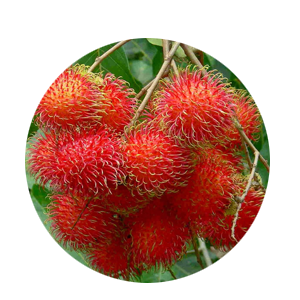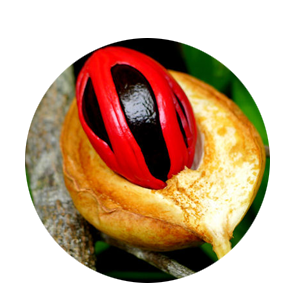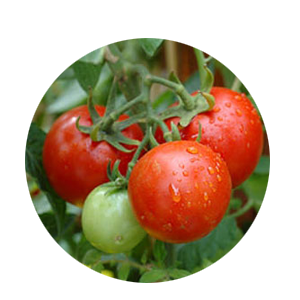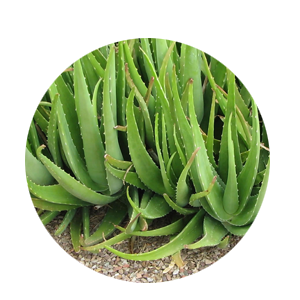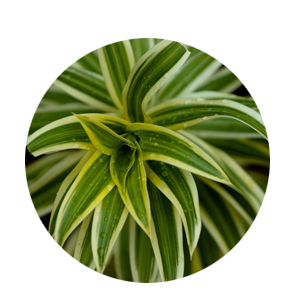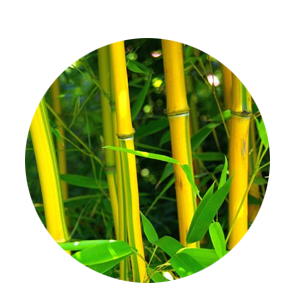Rambutan - Seedling - (5x7 bag)

Item Description
GENERAL INFORMATION ABOUT A RAMBUTAN The rambutan (Nephelium lappaceum) is a medium-sized tropical tree in the family Sapindaceae. The rambutan is native to the Malay-Indonesian region,and other regions of tropical Southeast Asia.It is closely related to several other edible tropical fruits including the lychee, longan, and mamoncillo. It is an evergreen tree growing to a height of 12–20 m.The leaves are alternate, 10–30 cm long, pinnate, with three to 11 leaflets, each leaflet 5–15 cm wide and 3–10 cm broad, with an entire margin. The flowers are small, 2.5–5 mm, and borne in erect terminal panicles 15–30 cm wide. The fruit is a round to oval single-seeded berry, 3–6 cm (rarely to 8 cm) long and 3–4 cm broad, borne in a loose pendant cluster of 10–20 together. The leathery skin is reddish (rarely orange or yellow), and covered with fleshy pliable spines, hence the name, which means \'hairs\'. The fruit flesh, which is actually the aril, is translucent, whitish or very pale pink, with a sweet, mildly acidic flavor very reminiscent of grapes. The single seed is glossy brown, 1–1.3 cm, with a white basal scar.[4] Soft and containing equal portions of saturated and unsaturated fats,[7] the seeds may be cooked and eaten. The peeled fruits can be eaten raw, or cooked and eaten: first, the grape-like fleshy aril, then the nutty seed, with no waste. HELTH BENENIFTS OF RAMBUTAN There are a lot of benefits of Rambutan to Health And Beauty and we will describe it one by one. 1-8 From Its Vitamin B3 Rambutan has a very high B3, amounting to 1352 mg. At 1950s, vitamin B3 is used to heart attack prevention therapy and lower cholesterol levels. Men should consume 15-19 mg per day, Women about of 15-18 mg per day, while for children 9-13mg daily. Here are some health benefits 1. Convert carbohydrates into energy 2. Lower Cholesterol Levels 3. Reduce the Risk of Atherosclerosis (Coronary Heart Disease) 4. Overcoming The Pellagra Syndrome 5. For The Beauty Of Skin, Hair, And Nails 6. As a beauty industry 7. Producing Sex Hormones 8. Diabetes 9-25 From Its Vitamin C 9. Improve Skin 10. Enhance The Body’s Immunity 11. Antioxidants 12. Hypertension 13. Blood vessel 14. Prevent lead poisoning 15. To lose weight 16. Cataract 17. Cancer 18. Heart disease 19. Asthma 20. Curing Disease Inflammation 21. Reduce fever 22. Black hair that was graying 23. For Pregnant Women
Maintanance, Disease Management And Yielding
MAINTANACE OF THE PLANTATION Once a plantation has been established, the work should not be considered finished. It will be necessary, for example, to protect the plantation against weather, fire, insects and fungi, and animals. A variety of cultural treatments also may be required to meet the purpose of the plantation. FERTILIZING For nursery beds for raising rootstocks/seedlings: 20:2:20 N, P2O5 and K2O + micronutrients; Apply to the foliage and soil once in a week by dissolving 1 g/litre water. For polybags used for transplanting rootstocks/seedlings: 20:2:20 N, P2O5 and K2O + micronutrients; Apply 10g once in 2 months. For Field planting 1–4 years: 6:6:6 or 8:8:8 20:2:20 N, P2O5 and K2O + micronutrients; Apply 100 g/tree, thrice a year. Gradually increase to 250g. 5th year onwards: Only N and K; Work out quantity depending on natural soil fertility. Apply twice a year. WATERING AND WEED CONTROL Young rambutan trees should be watered regularly until fully established. In dry western climates, water mature trees deeply at least every one or two weeks. Desert gardeners may have to water more frequently. Mulch the soil around the trees to conserve moisture. Weeding is also very important. Remove all weeds 1.5 meter around the plant. PRUNING AND SHAPE OF TREE Minimum pruning is needed just to remove the dead, diseased, broken branches and suckers. PEST & DISEASE FOR RAMBUTAN TREES Every fruit tree has the future potential for disease and insect damage. Factors such as location and weather will play a part in which issues your tree encounters. If available, disease-resistant trees are the best option for easy care; and for all trees, proper maintenance (such as watering, fertilizing, pruning, spraying, weeding, and fall cleanup) can help keep most insects and diseases at bay. HARVESTING YOUR RAMBUTAN TREE Rambutan trees start bearing fruits from fourth year onwards. It may take up to five months for the fruits to develop into ripe fruits from the onset of fruitset. Harvesting time in South East Asia is during July–September (main season) and December–February. Fruit yield per tree is upto 150 kg. But rambutan trees show a tendency for alternate bearing.
- Propogation Method : Seeds & Bulbs
- Plant Climate : Sub Tropical, Normal, Tropical
- Plant Height : 1-2 feet
- Plant Weight : 1 Kg
- Plant Polybagsize : 5x7
Related Images
- Botanical Name : Nephelium Lappaceum
- Malayalam Name : Rambutan
- English Name : Rambutan
If you consume this fruits regularly, you can get rid of intestinal parasites and also get relief from various symptoms of diarrhea and fever
Planting Instructions
PLANT THE RIGHT TREE AT RIGHT PLACE Growing space both above and below ground should be considered when selecting a tree to plant. Too often allowances are not made for the increased size of the tree when it matures. Most problems can be avoided by selecting the proper tree species for the available planting space. GENERAL TIPS 1. Plant at least 6 to 10 meter from main overhead utility wires on street or to your home. 2. Plant at least 7 meter from a building. 3. Plant at least 2 meter from sidewalks, driveways, patios and fences. 4. Plant at least 7 to 15 meter from other large trees. 5. Plant at least 7 meter from small trees. 6. Prioritize your tree planting with the sun’s direction to maximize shade by planting on the southwestern and western sides of your home BASIC PARAMETERS TO PLANT A RAMBUTAN TREE 1. Soil : A deep, friable and well-drained soil with rich organic matter content is is ideal soil for rambutan cultivation. Ideal soil pH is between 4.5 and 6.5. 2. Planting Distance : For Commercial Plantation:- A spacing of 10 m between plants is recommended for commercial cultivation of rambutan. For Home Garden: -In a home garden generally we are planting one or two rambutan trees along with other species of fruit plants. So it is better to keep minimum 7 meter distance from other plants to plant a rambutan tree. 3. Pit size : Minimum 60cm width X 60cm Breadth X 60cm depth 4. Sunlight : 100% sunlight is best but can grow up to 50 % shade 5. Watering: During dry weather, initially water the plant once in two days and after one month of planting water every 7 to 10 days during the first year. TEN TIPS FOR PLANTING A RAMBUTAN TREE 1. Dig a hole/pit 3 to 4 times wider than the container (Normally 60cm X 60cm X60cm is recommended). Fill the pit with top fertile soil to allow for proper root growth. Avoid clay type soil to refill the pit. 2. Add 250 gm Rock Phosphate or Born Meal and 3 to 5 kg Cow dung or compost in the top soil of the pit and mix it thoroughly (Thorough mixing of manure with soil is very important because direct contact of manure with the roots of the plant will cause the damage of roots and plant). 3. Make a small hole in the pit and carefully remove the plant from the container/pot or poly bag keeping the soil around the roots intact. Don‘t yank the plant out of the pot or poly bag as this can separate the roots from the tree. Poly bags can be easily removed by cutting it by a knife and pots can be removed easily by hitting slightly at the top edge of the pot. 4. Set the plant in the middle of the hole. Avoid planting the tree too deep. Keep the base of the trunk is slightly above ground level. Using some soil, secure the tree in a straight position, then fill and firmly pack the hole with the original soil, making sure there aren‘t any air pockets. 5. If the plant is Grafted or Budded make sure the grafted or budded portion of the plant is above the soil. Do not allow to touch the grafted or budded portion in the soil as it burns the skin of the plant. 6. Create a water-holding basin around the pit and give the plant a good watering. After the water has soaked in, spread protective mulch 2–4 inches deep in a 3-foot diameter area around the base of the tree, but not touching the trunk. Also provide a stich as a support for the plant, if needed. 7. The soil and mulch around your plant should be kept moist but not soggy. During dry weather, initially water the plant once in two days and after one month of planting water every 7 to 10 days during the first year. 8. Remove any tags and labels from the tree as these will affect the tree as it grows. You may need to prune any broken or dead branches. For Budded or Grafted plants it is very important that do not allow the growth of off shoots under the grafted/budded portion. Allow the growth of budded/grafted scions only. 9. Do not use chemical fertilizer or any other chemicals on your newly planted trees. Such products will kill your young trees. If needed you can add chemical fertilizers in small quantity (generally below 100gm) after two to three months of planting with sufficient irrigation. 10. Do not over water or allow rain water so much that you see standing water in the pit area of the plant. It will damage the plants roots and results the die of your plant.









